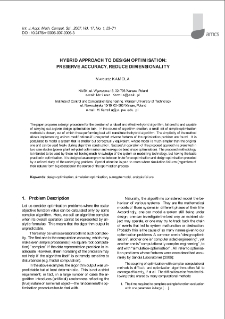Zielonogórska Biblioteka Cyfrowa udostępnia 64 636 obiektów cyfrowych
Obiekt
Tytuł: Hybrid approach to design optimisation: Preserve accuracy, reduce dimensionality
Współtwórca:
Korbicz, Józef (1951- ) - red.
Tytuł publikacji grupowej:
Abstract:
The paper proposes a design procedure for the creation of a robust and effective hybrid algorithm, tailored to and capable of carrying out a given design optimisation task. In the course of algorithm creation, a small set of simple optimisation methods is chosen, out of which those performing best will constitute the hybrid algorithm. The simplicity of the method allows implementing ad-hoc modifications if unexpected adverse features of the optimisation problem are found. ; It is postulated to model a system that is smaller but conceptually equivalent, whose model is much simpler than the original one and can be used freely during algorithm construction. Successful operation of the proposed approach is presented in two case studies (power plant set-point optimisation and waveguide bend shape optimisation). ; The proposed methodology is intended to be used by those not having much knowledge of the system or modelling technology, but having the basic practice in optimisation. It is designed as a compromise between brute force optimisation and design optimisation preceded by a refined study of the underlying problem. Special attention is paid to cases where simulation failures (regardless of their nature) form big obstacles in the course of the optimisation process.
Wydawca:
Zielona Góra: Uniwersytet Zielonogórski
Identyfikator zasobu:
DOI:
Strony:
Źródło:
AMCS, volume 17, number 1 (2007)
Jezyk:
Licencja CC BY 4.0:
Prawa do dysponowania publikacją:
Biblioteka Uniwersytetu Zielonogórskiego
Kolekcje, do których przypisany jest obiekt:
- Zielonogórska Biblioteka Cyfrowa > Repozytorium > Jednostki organizacyjne > Wydział Informatyki, Elektrotechniki i Automatyki
- Zielonogórska Biblioteka Cyfrowa > Repozytorium > Typy utworów > Artykuły
- Zielonogórska Biblioteka Cyfrowa > Repozytorium > Czasopisma naukowe i serie wydawnicze UZ > International Journal of Applied Mathematics and Computer Science (AMCS) > International Journal of Applied Mathematics and Computer Science (AMCS) (2007)
Data ostatniej modyfikacji:
14 lip 2025
Data dodania obiektu:
2 kwi 2024
Liczba wyświetleń treści obiektu:
119
Wszystkie dostępne wersje tego obiektu:
https://zbc.uz.zgora.pl/publication/88389
Wyświetl opis w formacie RDF:
Wyświetl opis w formacie OAI-PMH:
-
-
-
-
-
-
-
-
-
-
-
-
-
-
-
-
-
-
-
-
-
International Journal of Applied Mathematics and Computer Science (AMCS), volume 17, number 1 (2007)
-
International Journal of Applied Mathematics and Computer Science (AMCS), volume 17, number 2 (2007)
-
International Journal of Applied Mathematics and Computer Science (AMCS), volume 17, number 3 (2007)
-
International Journal of Applied Mathematics and Computer Science (AMCS), volume 17, number 4 (2007)
-
-
-
-
-
-
-
-
-
-
-
-
-
-
-
-
-
| Nazwa wydania | Data |
|---|---|
| Hybrid approach to design optimisation: Preserve accuracy, reduce dimensionality | 14 lip 2025 |
Obiekty Podobne
Hardier, Georges Seren, Cédric Ezerzere, Pierre Simani, Silvio - ed. Castaldi, Paolo - ed.
Pouraminian, Majid Pourbakhshian, Somayyeh Noroozinejad Farsangi, Ehsan Kuczyński, Tadeusz - red.
Pouraminian, Majid Pourbakhshian, Somayyeh Noroozinejad Farsangi, Ehsan Berenji, Sevil Keyani Borujeni, Salman Moosavi Asl, Mirhasan Mohammad Hosseini, Mehdi Kuczyński, Tadeusz - red.

